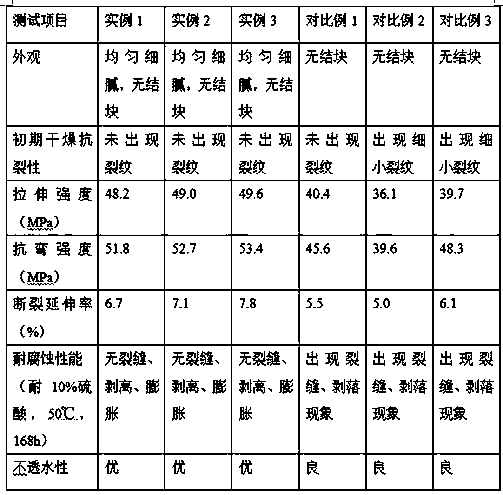Preparing method of glass-flake mastic resin
A technology of glass flakes and cement, which is applied in the direction of anti-corrosion coatings, coatings, etc., can solve problems such as shedding, poor corrosion resistance and impermeability, and easy cracking of glass flake cement, so as to prevent falling off, be difficult to crack and fall off, and improve Effect of Crosslink Density on Micro-Space Structure
- Summary
- Abstract
- Description
- Claims
- Application Information
AI Technical Summary
Problems solved by technology
Method used
Image
Examples
example 1
[0031] Preparation of reactants:
[0032] Weigh 500g of wheat straw and put it into a pulverizer to pulverize to obtain pulverized products. Mix the pulverized products with aluminum chloride at a mass ratio of 10:1 and put them into the reactor, impregnate them with distilled water, and fill the reactor with nitrogen until the pressure in the reactor rises. As high as 1.8MPa, raise the temperature in the kettle to 160°C, and react at constant temperature and pressure for 60 minutes to prepare the reactant.
[0033] Preparation of heat-treated products:
[0034] Put the above reactants and 4% sodium hydroxide solution into a beaker at a mass ratio of 1:5, mix and stir with a stirrer at a speed of 500r / min for 30min, filter after stirring to obtain a filter residue, and place the filter residue in a tubular In the furnace, the tube furnace was evacuated, the temperature in the furnace was raised to 230° C., and the heat treatment product was obtained by constant temperature he...
example 2
[0042] Preparation of reactants:
[0043] Weigh 600g of wheat straw and put it into a pulverizer to pulverize to obtain pulverized products. Mix the pulverized products with aluminum chloride at a mass ratio of 10:1 and put them into the reactor, impregnate them with distilled water, and fill the reactor with nitrogen until the pressure in the reactor rises. As high as 1.9MPa, raise the temperature in the kettle to 170°C, and react at constant temperature and pressure for 70 minutes to prepare the reactant.
[0044] Preparation of heat-treated products:
[0045] Put the above reactant and sodium hydroxide solution with a mass fraction of 6% into a beaker at a mass ratio of 1:5, mix and stir with a stirrer at a speed of 550r / min for 35min, filter after stirring to obtain a filter residue, and place the filter residue in a tubular In the furnace, the tube furnace was evacuated, the temperature in the furnace was raised to 235° C., and the heat treatment product was obtained by ...
example 3
[0053] Preparation of reactants:
[0054] Weigh 700g of wheat straw and put it into a pulverizer to pulverize to obtain pulverized products. Mix the pulverized products with aluminum chloride at a mass ratio of 10:1 and put them into the reactor, impregnate them with distilled water, and fill the reactor with nitrogen until the pressure in the reactor rises. As high as 2.0MPa, raise the temperature in the kettle to 180°C, and react at constant temperature and pressure for 80 minutes to prepare the reactant.
[0055] Preparation of heat-treated products:
[0056] Put the above reactant and sodium hydroxide solution with a mass fraction of 8% into a beaker at a mass ratio of 1:5, mix and stir with a stirrer at a speed of 600r / min for 40min, filter after stirring to obtain a filter residue, and place the filter residue in a tubular In the furnace, the tube furnace was evacuated, the temperature in the furnace was raised to 240° C., and the heat treatment product was obtained by ...
PUM
| Property | Measurement | Unit |
|---|---|---|
| quality score | aaaaa | aaaaa |
| quality score | aaaaa | aaaaa |
| quality score | aaaaa | aaaaa |
Abstract
Description
Claims
Application Information
 Login to View More
Login to View More - Generate Ideas
- Intellectual Property
- Life Sciences
- Materials
- Tech Scout
- Unparalleled Data Quality
- Higher Quality Content
- 60% Fewer Hallucinations
Browse by: Latest US Patents, China's latest patents, Technical Efficacy Thesaurus, Application Domain, Technology Topic, Popular Technical Reports.
© 2025 PatSnap. All rights reserved.Legal|Privacy policy|Modern Slavery Act Transparency Statement|Sitemap|About US| Contact US: help@patsnap.com

